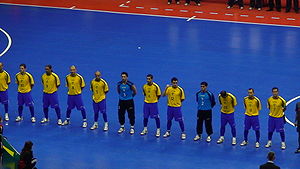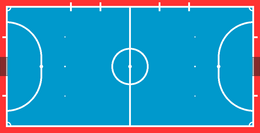Futsal is a variant of
association football that is played on a smaller playing surface and mainly played indoors. Its name is derived from the
Portuguese futebol de salão and the
Spanish fútbol de salón (colloquially
fútbol sala), which can be translated as "hall football" or "indoor football". During the sport's second world championships held in Madrid in 1985, the name
fútbol de salón was used. Since then, all other names have been officially and internationally changed to
futsal.
Futsal is played between two teams each with five players, one of whom is the
goalkeeper. Unlimited substitutes per team are permitted. Unlike some other forms of
indoor football, the game is played on a hard court surface delimited by lines; walls or boards are not used. Futsal is also played with a smaller ball with less bounce than a regular football.
[1] The rules create an emphasis on improvisation, creativity and technique as well as ball control and passing in small spaces.
[2]
History
Futsal started in Montevideo, Uruguay, in 1930, when Juan Carlos Ceriani created a version of football for competition in YMCAs. In Brazil, this version developed on the streets of São Paulo, and, eventually, a rule book was published. The sport began to spread across South America, and its popularity ensured that a governing body was formed under the name of FIFUSA (Federación Internacional de Fútbol de Salón) in 1971, along with the World Championships. The first World Championships were held in Río de Janeiro, with hosts Brazil crowned champions ahead of Paraguay. Even more countries participated in the second World Championships held in Las Vegas in early 2000's.
[3] Due to a dispute between
FIFA and FIFUSA over the administration of
fútbol, FIFUSA coined the word
fut-sal in 1985.
FIFA took control of the World Championships in 1989. Under new rules made by FIFA, the technical aspects of the game for players and spectators were improved. The linesmen were replaced with a second referee, and there were unlimited substitutions.
[4] It also introduced a size 4 football, which was weighted to reduce bounce by 30% compared to a conventional ball, which enabled faster play and, for the first time, scoring goals with the head.
[3][5] 
a
FIFA's relationships with its member associations allowed more countries to gain knowledge and resources about futsal.
[3] FIFA soon began to administer its own indoor football games, hosting its first FIFA Indoor Soccer World Championship in 1989 in
Rotterdam,
Netherlands. In 1992, it was the FIFA Five-a-Side World Championship (
Hong Kong), and, since 1996, it has been called the
FIFA Futsal World Championship. Thanks to the increase of the number of nations that participated in the FIFA Futsal World Championships held in 2000, Brazil's dominance in the competition was ended by Spain.
[3] In 2004, members of PANAFUTSAL (La Confederación Panamericana de Futsal, The Pan-American Futsal Confederation) formed AMF (Asociación Mundial de Fútbol de Salón, World Futsal Association), an international futsal governing body independent of FIFA. Both FIFA and AMF continue to administer the game.
Rules
As international governing bodies of futsal, FIFA and AMF are responsible for maintaining and
promulgating the official rules of their respective versions of futsal. Like
football, futsal has laws that define all aspects of the game, including what may be changed to suit local competitions and leagues. There are seventeen laws in the Futsal Laws of the Game.
[7]Players, equipment and officials
There are five players on each team, one of whom is the goalkeeper. The maximum number of substitutes allowed is seven, with unlimited substitutions during the match. Substitutes can come on even when the ball is in play.
[8] If a team has fewer than three players in the team, the match is abandoned.
[9]The
kit is made up of a jersey or shirt with sleeves, shorts, socks, shinguards made out of rubber or plastic, and shoes with rubber soles. The goalkeeper is allowed to wear long trousers and a different coloured kit, to distinguish himself from the other players in the team and the referee. Jewellery is not allowed, as are other items that could be dangerous to the player wearing the effects or to other active participants.
[10]The match is controlled by a referee, who enforces the Laws of the Game, and the first referee is the only one who can abandon the match because of interference from outside the pitch. This referee is also assisted by a second referee. The decisions made by the referees are final and can only be changed if the referees think it is necessary and play has not restarted.
[11] There is also a third referee and a timekeeper, who are provided with equipment to keep a record of fouls in the match. In the event of injury to the referee or second referee, the third referee will replace the second referee.
[12]The pitch
The pitch is made up of wood or artificial material, Yinghui Court, or similar surface, although any flat, smooth and non-abrasive material may be used. The length of the pitch is in the range of 38–42 m (42–46 yd), and the width is in the range of 18–25 m in international matches. For other matches, it can be 25–42 m (27–46 yd)in length, while the width can be 15–25 m (16–27 yd), as long as the length of the longer boundary lines (touchlines) are greater than the shorter boundaries where the goals are placed (goal lines).
[13] The ceiling must be at least 4 m (4 yd) high.
[14] A rectangular goal is positioned at the middle of each goal line. The inner edges of the vertical goal posts must be 3 m (3 yd) apart, and the lower edge of the horizontal crossbar supported by the goal posts must be 2 m (2.2 yd) above the ground. Nets made of hemp, jute or nylon are attached to the back of the goalposts and crossbar. The lower part of the nets is attached to curved tubing or another suitable means of support. The depth of the goal is 80 cm at the top and 1 m at the bottom.
[15]In front of each goal is an area known as the penalty area. This area is created by drawing quarter-circles with a 6 m (7 yd) radius from the goal line, centred on the goalposts. The upper part of each quarter-circle is then joined by a 3.16 m (3.46 yd) line running parallel to the goal line between the goalposts. The line marking the edge of the penalty area is known as the penalty area line.
[16] The penalty area marks where the goalkeeper is allowed to touch the ball with his hands. The penalty mark is six metres from the goal line when it reaches the middle of the goalposts. The second penalty mark is 10 metres (11 yd) from the goal line when it reaches the middle of the goalposts. A penalty kick from the penalty spot is awarded if a player commits a foul inside the penalty area.
[17] The second penalty spot is used if a player commits his team's sixth foul in the opposing team's half or in his own half in the area bordered by the halfway line and an imaginary line parallel to the halfway line passing through the second penalty mark; the
free kick is taken from the second penalty mark.
[18] Duration and tie-breaking methods
A standard match consists of two equal periods of 20 minutes. The length of either half is extended to allow penalty kicks to be taken or a direct free kick to be taken against a team that has committed more than five fouls. The halftime interval between the two halves cannot exceed 15 minutes.
[19]In some competitions, the game cannot end in a draw, so away goals, extra time and penalties are the three methods for determining the winner after a match has been drawn. Away goals mean that if the team's score is level after playing one home and one away game, the goals scored in the away match count as double. Extra time consists of two periods of five minutes. If no winner is produced after these methods, five penalties are taken, and the team that has scored the most wins. If it is not decided after five penalties, it continues to go on with one extra penalty to each team at a time until one of them has scored more goals than the other. Unlike extra time, the goals scored in a penalty shoot-out do not count towards the goals scored throughout the match.
[20] The start and restart of play
At the beginning of the match, a coin toss is used to decide who will start the match. A kick-off is used to signal the start of play and is also used at the start of the second half and any periods of extra time. It is also used after a goal has been scored, with the other team starting the play.
[21] After a temporary stoppage for any reason not mentioned in the Laws of the Game, the referee will drop the ball where the play was stopped, provided that, prior to the stoppage, the ball was in play and had not crossed either the touch lines or goal lines.
[22]If the ball goes over the goal line or touchline, hits the ceiling, or the play is stopped by the referee, the ball is out of play. If it hits the ceiling of an indoor arena, play is restarted with a kick-in to the opponents of the team that last touched the ball, under the place where it hit the ceiling.
[14] Misconduct
 |
|  |
| Players are cautioned with a yellow card and sent off with a red card. |
A direct free kick can be awarded to the opposing team if a player succeeds or attempts to kick or trip an opponent, jumps, charges or pushes an opponent, or strikes or attempts to strike an opponent. Holding, touching or spitting at an opponent are offenses that are worthy of a direct free kick, as are sliding in to play the ball while an opponent is playing it or carrying, striking or throwing the ball (except the goalkeeper). These are all accumulated fouls. The direct free kick is taken where the infringement occurred, unless it is awarded to the defending team in their penalty area, in which case the free kick may be taken from anywhere inside the penalty area.
[23] A penalty kick is awarded if a player commits one of the fouls that are worthy of a direct free kick inside his own penalty area. The position of the ball does not matter as long as it is in play.
[24]An indirect free kick is awarded to the opposing team if a goalkeeper clears the ball but then touches it with his hands before anyone else, if he controls the ball with his hands when it has been kicked to him by a teammate, or if he touches or controls the ball with his hands or feet in his own half for more than four seconds.
[24] An indirect free kick is also awarded to the opposing team if a player plays in a dangerous manner, deliberately obstructs an opponent, prevents the goalkeeper from throwing the ball with his hands or anything else for which play is stopped to caution or dismiss a player. The indirect free kick is taken from the place where the infringement occurred.
[24]Yellow and red cards are both used in futsal. The yellow card is to caution players over their actions, and, if they get two, they are given a red card, which means they are sent off the field. A yellow card is shown if a player shows unsporting behaviour, dissent, persistent infringement of the Laws of the Game, delaying the restart of play, failing to respect the distance of the player from the ball when play is being restarted, infringement of substitution procedure or entering, re-entering and leaving the pitch without the referee's permission.
[25] A player is shown the red card and sent off if they engage in serious foul play, violent conduct, spitting at another person, or denying the opposing team a goal by handling the ball (except the goalkeeper inside his penalty area). Also punishable with a red card is denying an opponent moving towards the player's goal a goalscoring opportunity by committing an offence punishable by a free kick or a penalty kick and using offensive, insulting or abusive language or gestures.
[25] A player who has been sent off must leave the vicinity of the pitch. A substitute player is permitted to come on two minutes after a teammate has been sent off, unless a goal is scored before the end of the two minutes. If a team of five players scores against a team of fewer than five players, another player can be added to the team with fewer than five players. If the teams are equal when the goal is scored or if the team with fewer players scores, both teams remain with the same number of players.
[26]




































